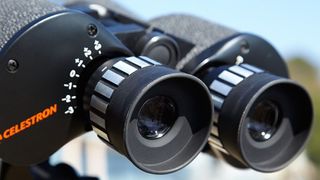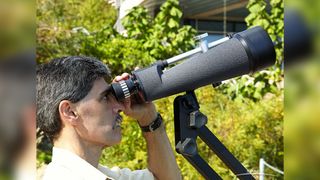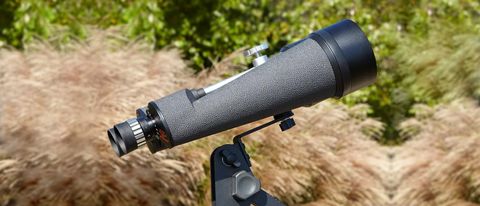Space Verdict
At 156 ounces, Celestron's SkyMaster 25x100s are impossible to hold steady on the stars by hand. Don’t even try. But perch them on a suitably hefty mount and they’ll convey an optically accurate sky-watching experience that can move your soul.
Pros
- +
High magnification
- +
Tripod adapter included
- +
Great clarity and contrast
Cons
- -
Very heavy, tripod needed
- -
Quite expensive
Why you can trust Space.com
Bigness is a virtue in telescopes — most of the time. The larger the light-bucket, the more photons ('raindrops' of light) it can collect. But big telescopic instruments are also heavier, more ungainly and can demand greater care and feeding. We've chosen the Celestron SkyMaster 25x100 binoculars as our top pick for large astronomy binoculars, which is why they sit in our buying guide of the best binoculars for stargazing.
Magnification: 25x
Objective lens diameter: 100mm
Angular field of view: 3 degrees
Eye relief: 15mm
Weight: 9 lbs, 12 oz
In the case of binoculars, serving up the universe in stereo gives you more than double the pleasure of one-eye on the sky. But servicing the demands of two eyes more than doubles the mass of the optical system. So as you scale up from the small portable 'field glasses' that might be great for watching, say, fast-moving race cars, to the larger apertures appropriate for resolving the majesty of the slowly revolving stars, the glass gets very heavy, very quickly.
Celestron SkyMaster 25x100: Design
- Requires tripod to use (and possibly counter-weighted arm)
- Solid in the hand reinforced by a metal bar down the binoculars
- Objective lens covers are easy to lose

So, buying these Celestrons means also buying a tripod and maybe a counter-weighted arm. But the binoculars are ready when you do: A solid-feeling reinforced metal bar forms a keel, from the objective lens covers at the front to the bulbous prism warts towards the rear. A built-in tripod adapter slides along this spine; a knurled knob tightens the adapter down at your preferred position. And when your observing night is over, the bar makes a comfortably grip-able lifting fixture; which you've likely set at the natural balance point. So you can one-hand these heavy beasts into their protective case.
Now that you're set up, have a good look at your Celestron SkyMaster 25x100s, starting at the business end where you’ll put your eyes. The 4mm exit pupils (the bright spots of the actual image) look eerily small surrounded by the large-looking 20 mm eyepieces. But they're big enough to fill most adults' dark-adapted eyes. And the 15 mm eye relief (the distance from the eyepiece's surface to the last spot a full-width image can be seen) is long enough for eyeglass wearers to get a well-focused broad view. You probably won't even have to fold down the rubber eyepiece guards.
Additionally, the floppy rubber objective lens covers really don't want to stay put. They will dive off the tubes and steal away into the night at their first opportunity. Don't ever let them get the drop on you.
Celestron SkyMaster 25x100: Functionality
- 450 degree, independent eyepiece rotation
- Binocular padded pack not wholly suitable for the size of binoculars
- Impressively, it feels like looking through two telescopes

Each eyepiece independently rotates through 450 degrees to provide critical sharp focus. They aren't really diopters, such as you find on lower-power binoculars. It's best to think of this whole rig as a pair of side-by-side 100 mm refractor telescopes, with image-erecting prisms built-in, and separate non-removable eyepieces
We were a little let down at the way Celestron ships these instruments. For the price point, we expected a solid, lined shock-resistant case. Instead, the 25x100s come swaddled in a thinly padded fabric binocular cozy, which slips into an even thinner nylon soft pack with a shoulder strap. There's a thin elastic strap that’s supposed to restrain the mass. But it's too easy for the heavy binoculars to slip out of the cozy and onto the hard ground.
The documentation shipping with the 25x100s is also a little disappointing. It's just the generic Celestron SkyMaster one-pager. A lot of the information applies only to the smaller members of the SkyMaster line. These big guys, for example, have no center-focus knob; you set the eyepieces independently.
Celestron SkyMaster 25x100: Performance
- Waterproof binoculars (we think)
- Rough metal design stops it slipping out of the hand
- Perfect for finding clusters of galaxies — within reason

These SkyMasters have the word waterproof printed on them, though the rubble-y metallic finish won't give you immediate confidence in that claim. Celestron's online specifications for the 25x100s only declare water resistant. We expected a rubber coating. The rough metal does bestow a sense of non-slip security when hand-holding or pointing your rig.
At the typical temperatures of night-sky observation, the surface feels quite cold to the touch. That's actually a good thing. It suggests these Celestron's will equilibrate (cool) to ambient temperature faster than better-insulated binoculars. This isn't as big a deal as it is with telescopes, especially mirrored ones (Newtonians and Cassegrains), but it's nice for all your optical surfaces to maintain their relative geometries.
Also, there's no inter-pupil distance (IPD) scale; it would be next to useless in the dark anyway. Besides, large astronomy binoculars tend to be personal items; you'll set your IPD — and likely, the focus too (at infinity) — the first time you use them. Thereafter, you'll seldom do more than tweak these back to your custom settings.
Jump to the other end of the binoculars — look backwards through the 100 mm objective lenses — and you'll notice the barrels' interiors are well knurled. Small raised rings down the length of the tubes act as light diffusers, baffling the prisms from late-arriving rays and reducing scattered light, which can compromise your image.
And the images these big eyes can pass are astounding. I like trying to pick out clusters of galaxies in large binoculars, like springtime's Leo Triplets (they aren't really siblings). But just to manage expectations, some of the best galaxy groups are too faint and faraway for even big binoculars, like autumn's Stephan's Quintet (they don't really play music, anyway).
Should you buy the Celestron SkyMaster 25x100 binoculars?
These heavy-hitters are certainly not for the uninitiated binoculars-users. Despite being labelled as such, we've already mentioned that they're more like two 100mm refractor telescopes glued together and they give enormous reach. Therefore, they're not suitable for handheld use as it'd be too hard to keep them steady and would end in arm ache.
However, despite a few aforementioned cost-saving skimps, these Celestron SkyMaster 25x100 binoculars are still our favorites for large astronomy binoculars. With proper care, they could give you decades of joyful stereoscopic star-hopping.
If the Celestron SkyMaster 25x100 binocular isn't right for you
Of course, there are many that might find these binoculars too unwieldy so a smaller pair that retains good reach would be the Celestron Nature DX 12x56 binoculars. They have fantastic rubberized grips, and comfortable eyepieces that are adjustable for spectacles-wearers and give a sharp and bright image whilst remaining effortlessly portable.
Those seeking a pair that are slightly more affordable may want to turn to the Opticron Adventurer II WP 10x50 binoculars. They're a great budget pair that are lightweight and provide excellent eye relief. This pair feels a little cheap in the hand but where Opticron hasn't skimped is in the optical design — providing satisfying, clear views of the night sky or any other daytime subject.
Join our Space Forums to keep talking space on the latest missions, night sky and more! And if you have a news tip, correction or comment, let us know at: community@space.com.
Dave Brody has been a writer and Executive Producer at SPACE.com since January 2000. He created and hosted space science video for Starry Night astronomy software, Orion Telescopes and SPACE.com TV. A career space documentarian and journalist, Brody was the Supervising Producer of the long running Inside Space news magazine television program on SYFY. Follow Dave on Twitter @DavidSkyBrody.
- Jase Parnell-BrookesChannel Editor


